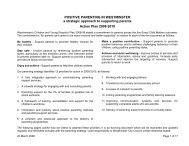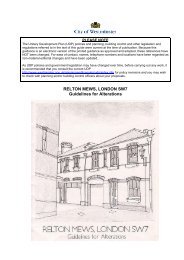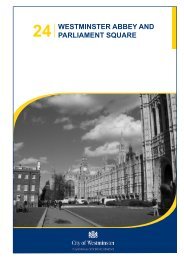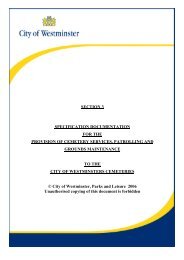Statement of Licensing Policy (2008) WCC - Westminster City Council
Statement of Licensing Policy (2008) WCC - Westminster City Council
Statement of Licensing Policy (2008) WCC - Westminster City Council
Create successful ePaper yourself
Turn your PDF publications into a flip-book with our unique Google optimized e-Paper software.
Reasons for <strong>Policy</strong> PN12.2.9 The <strong>Licensing</strong> Authority will expect applicants to set out in their Operating Schedulesthe steps taken, or proposed to be taken, to deal with the potential for publicnuisance arising from the operation <strong>of</strong> the premises or open air site under the licence.Applicants should identify and describe through a risk assessment how these risks willbe managed. Public nuisance could include low-level nuisance perhaps affecting afew people living locally as well as major disturbance affecting the whole community(revised Guidance, paragraph 2.33). It may also include, in appropriate circumstances,a reduction <strong>of</strong> the living and working amenity and environment <strong>of</strong> interested parties inthe vicinity <strong>of</strong> licensed premises.2.2.10 <strong>Westminster</strong> has a substantial residential population and the council as the <strong>Licensing</strong>Authority has a duty to protect it from nuisance. In certain areas, the increasedconcentration <strong>of</strong> entertainment uses and the longer hours <strong>of</strong> operation have adverselyaffected local residents. Commercial occupiers <strong>of</strong> premises also have a legitimateexpectation <strong>of</strong> an environment that is attractive and helps sustain their businesses.The role <strong>of</strong> the council as <strong>Licensing</strong> Authority is to maintain an appropriate balancebetween the legitimate aspirations <strong>of</strong> the entertainment industry and the needs <strong>of</strong>residents and other users <strong>of</strong> the city including, businesses, workers, shoppers andvisitors. It will need to satisfy itself that adequate measures to prevent public nuisanceare in place and will be maintained. These principles apply also to events in open airsites.2.2.11 Playing <strong>of</strong> music can cause nuisance both through noise breakout and by its effecton patrons, who become accustomed to high sound levels and to shouting to makethemselves heard, which can lead to them being noisier when leaving premises. Thelater that music is played, the greater the potential for nuisance. Other major sources<strong>of</strong> noise nuisance are vehicles collecting customers; the slamming <strong>of</strong> car doors andthe sounding <strong>of</strong> horns resulting from congestion and pressure for on-street parkingspace and the servicing <strong>of</strong> premises. These noises can be particularly intrusiveat night when ambient noise levels are lower. Other impacts include: noise fromcustomers smoking, drinking, and eating in the open-air, the servicing <strong>of</strong> premises,and noise and smells from ducts and ventilation equipment. There are similar issuesthat apply to the operation <strong>of</strong> events at open air sites.2.2.12 Residents are <strong>of</strong>ten subjected to nuisance from the noise <strong>of</strong> people on their way toand from premises, and loitering in the streets after they have left premises. This can29
















